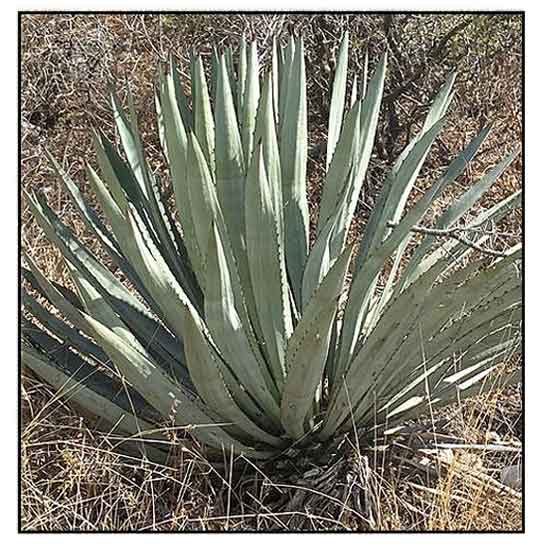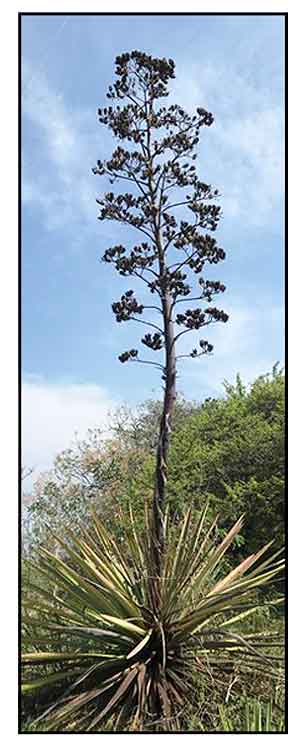 Gen info Gen info
- Agave is a genus of monocots native to the hot and arid regions of the Americas and the Caribbean; some are native to tropical areas of North America, such as Mexico.
-
Brought by the Spanish to the Philippines, Indonesia, and Malaysia, evolving into a fiber crop, in the 19th century developed into the Cantala fiber industries in the Philippines and Indonesia.
- Cantala production is mainly concentrated in the Philippines, Indonesia and India. In the early 20th Century, annual production of cantala fiber in northern Luzon and western Visayas reached 19,000 t annually, 14,000 t of which was exported. A post WWII decline, together with shift of farming into more profitable endeavors, the developed of other natural fibers and synthetics for cordage, prohibition of seawater-retting, lower pricing have caused considerable decrease production, about 32 t in annually from 1996-2000. (2)
- Taxon confusion: The confusion of Agave vivipara L. and A. angustifolia, considered conspecific by Wijnands, are shown to be two distinct species. A previous neotypification of A. angustifolia by Gentry is superseded because it is in conflict with the protologue.
(12)
- Etymology: The genus name Agave derives from ancient Greek agaue from agauous meaning "illustrious, noble", referring to the very tall flower spikes found in many species.
The genus was erected by Carl Linnaeus in 1753, initially for four species. The genus has traveled various families, Liliacea to Agavaceae to Asparagaceae. (13)
Botany
Agave vivipara is a stemless, evergreen, succulent perennial plant forming a large, rosette of leaves up to 2 meters tall, forming a flowering stem that can be up to 8 m high towards the end of its life.
Distribution
- Almost certainly introduced from Mexico.
- Naturalized in tropical Asia countries centuries ago and now common in South and South-East Asia from India to the Philippines. (2)
- Ornamental cultivation.
Constituents
- Total phenolic content of methanolic extract of whole plant was 6.5 mg catechol /g. Total flavonoid content was 7.4 mg quercetin / g. Preliminary phytochemical screening yielded alkaloids, carbhohydrates, flavonoids, saponins, phenols, amino acids, proteins, and phytosterols. (see study below) (4)
- Study of fruits isolated a new steroidal glycoside, agaveside C, characterized as 3β-{α-l-rhamnopyranosyl-(1→2)-β-d-glucopyranosyl-(1→3)-β-d-glucopyranosyl-[β-d-xylopyranosyl-(1→4)-α-l-rhamnopyranosyl-(1→2)]-β-d-glucopyranosyl}-2α-hydroxy-25R-5α-spirostane. (6)
Properties
Studies have suggested cytotoxicity, antioxidant, anti-inflammatory, molluscicidal, antibacterial properties.
Parts used
Leave, roots, fibers.
 Uses Uses
Edibility
- In Java, shoot buds eaten as cooked vegetable.
- In Mexico, cultivated for the production of a viscous alcoholic drink, "pulque", which can be distilled to produce mezcal. (2)
- Stems of the plant excretes sap, when chopped by a knife it yields a sweet liquid called agua miel (honey water), which is fermented to produced pulque. (10)
- Agave syrup (agave nectar) is marketed as a healthy natural sugar substitute.
Folkloric
- Leaves used in the treatment of wounds.
- Plant parts used in folklore as laxative, emmenagogue, diuretic, aphrodiasiac, antisyphilitic, anticancer, and antiscurvy. (5)
- Used for treatment of jaundice and sprains.
- In Kerala, India, Kuruma tribe apply root extract on wounds.
- In Mexico, mezcal, distilled from pulque, is taken before breakfast to treat hypertension and diabetes, and as an aphrodisiac.
Others
- Fiber: Leaves are a source of fiber. The fiber belongs to the "hard fibers" of commerce, along wit abaca (Musa textilis) and sisal (Agave sisalana). Cantala fibers are made into baskets, hammocks, bags, sandals, carpets, rugs, doormats, sacks, cordage and as fishing gear. It is blended with abaca fiber in the manufacture of ropes, carpets, binder twine, fishing nets, slippers, and various decorative items. (2)
- Agroforestry: In Indonesia, used as hedges to protect homesteads or fields from grazing animals. (2)
- Fodder: In Mexico, fleshy leaves used as fodder. (2)
- Insecticidal: Acetone extract of leaves has shown weak insecticidal effects against diamondback moth (Plutella xylostella). (2)
- Ethnoveterinary: In Nepal, juice extracted from boiled leaves given orally to cure fever. (8)
- Others: Roots are a great source of saponins that can be used as substitute for soap.
Studies
• Anti-Inflammatory / Antioxidant / Whole Plant: Study evaluated a methanolic extract of Agave cantala for anti-inflammatory and antioxidant properties using in vivo and in vitro methods in rats. In acute model of inflammation, results showed anti-inflammatory activity against carrageenan (46.15% and 61.53%) and dextran (20.56% and 26.33%) at doses of 200 and 400 mg/kg. In chronic model of inflammation using cotton pellet granuloma, there was 25.63% and 44.97% activity at 200 and 400 mg/kg. The ME significantly reduced number of writhing induced by acetic acid and hot-plate test. The ME also displayed inhibitory effect of hydroxyl radical scavenging activity. The ME showed strong reducing power by FRAP assay. Acute oral toxicity study at 2000 mg/kbw showed no signs of toxicity over a 14-day observation period. (see constituents above) (4)
• Cytotoxicity by Brine Shrimp Lethality Assay: BSLA is a simple, reliable, and convenient method to assess bioactivity of medicinal plants. Study evaluated the cytotoxicity of aqueous and alcoholic extracts of Agave cantula by Brine Shrimp Lethality Assay. The aqueous and alcoholic extracts exhibited potent brine shrimp lethality with LC50 of 15 and 12.5 mg/ respectively. (5)
• Molluscicidal / Saponins / Leaves: Study of methanol extract of leaves isolated three spirostanol glycosides, cantalasaponins 6-8. Cantalasaponin-7 exhibited weak activity towards Biomphalaria glabrata, the snail vector of the parasitic disease schistosomiasis. (7)
• Composite Fibers as Prosthetic Socket Material: Study evaluated the use of Agave cantala-based composite fibers as prosthetic socket materials. Natural fibers have advantages i.e., biodegradable, adequate strength and power, and good mechanical resistance. Alkaline treatment reduced contact angle and increased surface energy. The product exceeds tensile and flexural strength of materials commonly used in prosthetic sockets on the market. (7)
• Antibacterial: Study evaluated plant fiber extracts of Agave cantula and Typha angustifolia for antimicrobial activity against gram-positive B. subtilis and gram-negative E. coli. A total of 24 methanol and acetone soxhlet extracts from the 2 plants were subjected to antimicrobial screening. All 24 samples exhibited positive inhibition zones of activity. Acetone extracts showed more inhibitory activity than methanol extracts, and higher inhibitory activity against gram positive bacteria. (10)
Availability
Wild-crafted.
Cultivated.
|

![]()





